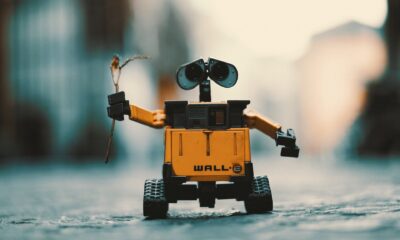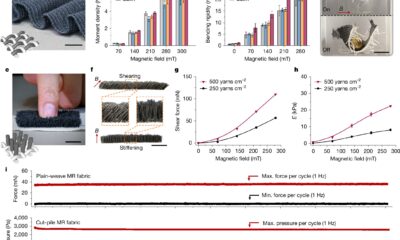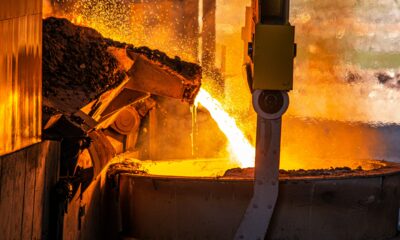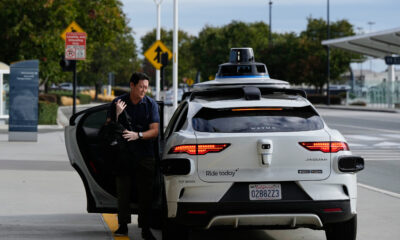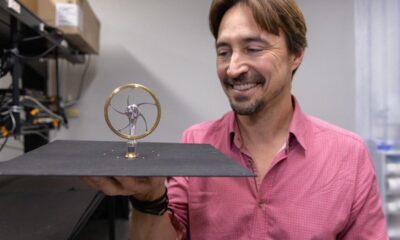Tech
‘Energy sandwich’ could power next-generation solar and lighting

Researchers have achieved a new level of control over the atomic structure of a family of materials known as halide perovskites, creating a finely tuned “energy sandwich” that could transform how solar cells, LEDs and lasers are made.
Due to their remarkable ability to absorb and emit light, and because they are cheaper and can be configured to convert more of the solar spectrum into energy than silicon, perovskites have long been touted as a potential replacement for silicon in solar cells, LEDs and quantum technologies.
However, their instability and durability has, so far, largely limited perovskite devices to the laboratory. In addition, scientists have struggled to precisely control the thickness of perovskite films, and control how different perovskite layers interact when stacked together—an important step in building functional, multi-layered structures.
Breakthrough in perovskite film growth
Now, a team of researchers led by the University of Cambridge has found a new way to grow ultra-thin layers of perovskite films so their atoms line up perfectly, which could enable more powerful, durable and efficient devices.
The researchers used a vapor-based technique to grow three-dimensional and two-dimensional perovskites one layer at a time, which enabled them to control the thicknesses of the films down to fractions of an atom.
Their results, reported in the journal Science, could open the door to usable perovskite devices that can be produced at scale, using a process like that used to make commercial semiconductors.
Each layer in a semiconductor “sandwich” does a different job in moving electrons and their positively-charged counterparts—called holes—around and determines how the semiconductors absorb or emit light. Together, the layers act like one-way streets that guide the electric charges in opposite directions, preventing them from bumping back into each other and wasting energy as heat.
In other widely-used semiconductors, such as silicon or newer materials such as gallium nitride, the properties of the individual layers can be fine-tuned using various methods. But perovskites, despite their excellent performance, have so far proved difficult to control in layered devices, due in part to their ‘chaotic’ atomic structure.

Vapor processing enables atomic precision
“A lot of perovskite research uses solution processing, which is messy and hard to control,” Professor Sam Stranks from the Department of Chemical Engineering and Biotechnology, who co-led the research, said.
“By switching to vapor processing—the same method used for standard semiconductors—we can get that same degree of atomic control, but with materials that are much more forgiving.”
The researchers used a combination of three-dimensional and two-dimensional perovskites to create and control their atomically-tuned stacks, a phenomenon known as epitaxial growth. This fine control let the team directly observe how the light given off by the material changes depending on whether it’s a single layer, a double layer, or thicker.
“The hope was we could grow a perfect perovskite crystal where we change the chemical composition layer by layer, and that’s what we did,” said co-first author Dr. Yang Lu from Cambridge’s Department of Chemical Engineering and Biotechnology and Cavendish Laboratory.
“It’s like building a semiconductor from the ground up, one atomic layer after another, but with materials that are much easier and cheaper to process.”
Controlling charge behavior and device potential
The researchers also found they could engineer the junctions between the layers to control whether electrons and holes stayed together or apart—a key factor in how efficiently a material emits light.
“We’ve reached a level of tunability that wasn’t even on our radar when we started,” said Professor Sir Richard Friend from the Cavendish Laboratory, who co-led the research.
“We can now decide what kind of junction we want—one that holds charges together or one that pulls them apart—just by slightly changing the growth conditions.”
The researchers found they could tune the energy difference between the layers by more than half an electron volt, and in some cases, extend the lifetime of electrons and holes to over 10 microseconds: far longer than usual.
The team says this level of precision could pave the way for scalable, high-performance devices that use light in new ways, from lasers and detectors to next-generation quantum technologies.
“Changing the composition and performance of perovskites at will—and probing these changes—is a real achievement and reflects the amount of time and investment we’ve made here at Cambridge,” said Stranks.
“But more importantly, it shows how we can make working semiconductors from perovskites, which could one day revolutionize how we make cheap electronics and solar cells.”
More information:
Yang Lu et al, Layer-by-layer epitaxial growth of perovskite heterostructures with tunable band offsets, Science (2025). DOI: 10.1126/science.adx5685. www.science.org/doi/10.1126/science.adx5685
Citation:
‘Energy sandwich’ could power next-generation solar and lighting (2025, November 13)
retrieved 13 November 2025
from https://techxplore.com/news/2025-11-energy-sandwich-power-generation-solar.html
This document is subject to copyright. Apart from any fair dealing for the purpose of private study or research, no
part may be reproduced without the written permission. The content is provided for information purposes only.
Tech
Robots trained with spatial dataset show improved object handling and awareness
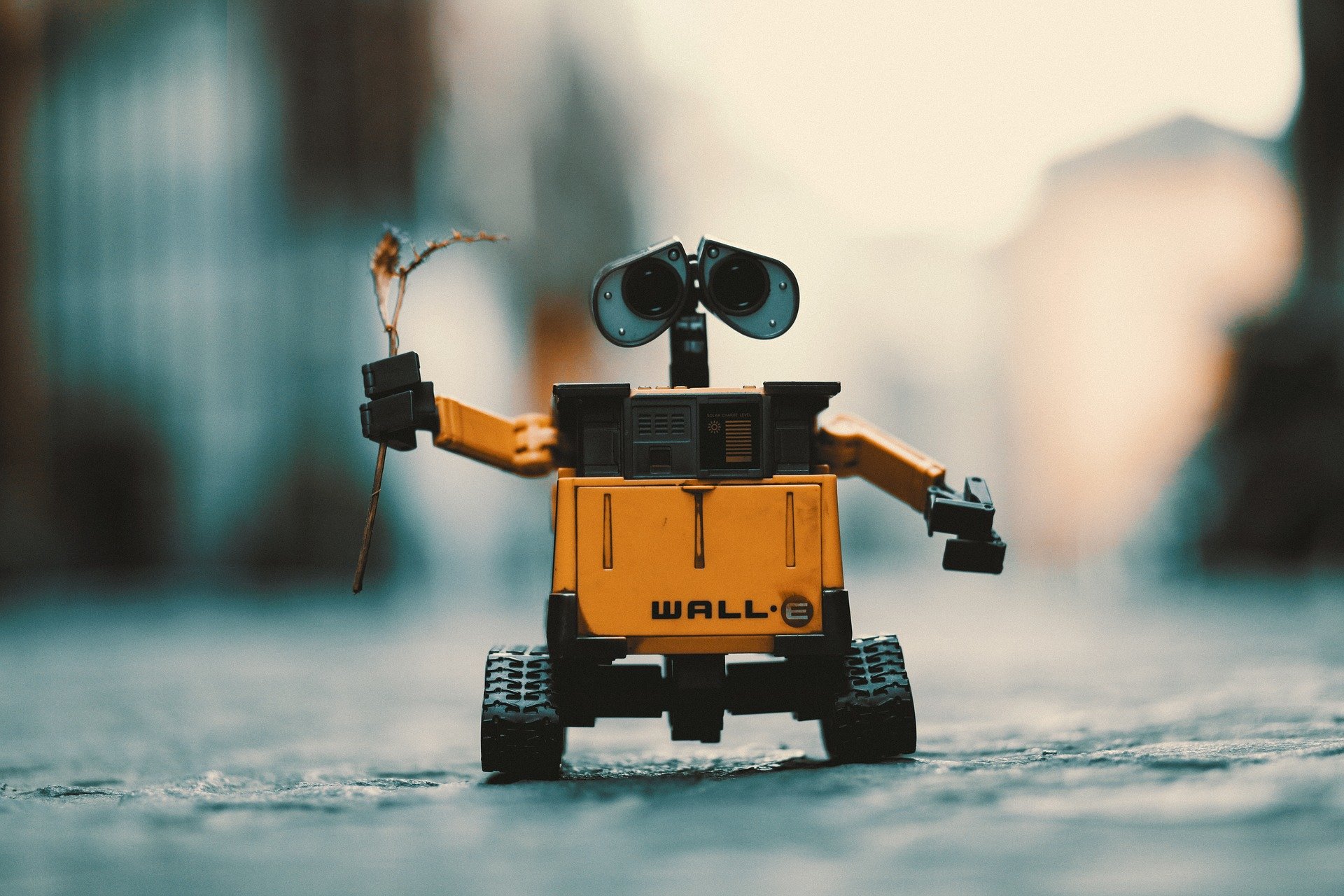
When it comes to navigating their surroundings, machines have a natural disadvantage compared to humans. To help hone the visual perception abilities they need to understand the world, researchers have developed a novel training dataset for improving spatial awareness in robots.
In new research, experiments showed that robots trained with this dataset, called RoboSpatial, outperformed those trained with baseline models at the same robotic task, demonstrating a complex understanding of both spatial relationships and physical object manipulation.
For humans, visual perception shapes how we interact with the environment, from recognizing different people to maintaining an awareness of our body’s movements and position. Despite previous attempts to imbue robots with these skills, efforts have fallen short as most are trained on data that lacks sophisticated spatial understanding.
Because deep spatial comprehension is necessary for intuitive interactions, if left unaddressed, these spatial reasoning challenges could hinder future AI systems’ ability to comprehend complex instructions and operate in dynamic environments, said Luke Song, lead author of the study and a current Ph.D. student in engineering at The Ohio State University.
“To have true general-purpose foundation models, a robot needs to understand the 3D world around it,” he said. “So spatial understanding is one of the most crucial capabilities for it.”
The study was recently given as an oral presentation at the Conference on Computer Vision and Pattern Recognition. The work is published in the journal 2025 IEEE/CVF Conference on Computer Vision and Pattern Recognition (CVPR).
To teach robots how to better interpret perspective, RoboSpatial includes more than a million real-world indoor and tabletop images, thousands of detailed 3D scans, and 3 million labels describing rich spatial information relevant to robotics. Using these vast resources, the framework pairs 2D egocentric images with full 3D scans of the same scene so the model learns to pinpoint objects using either flat-image recognition or 3D geometry.
According to the study, it’s a process that closely mimics visual cues in the real world.
For instance, while current training datasets might allow a robot to accurately describe a “bowl on the table,” the model would lack the ability to discern where on the table it actually is, where it should be placed to remain accessible, or how it might fit in with other objects. In contrast, RoboSpatial could rigorously test these spatial reasoning skills in practical robotic tasks, first by demonstrating object rearrangement and then by examining the models’ capacity to generalize to new spatial reasoning scenarios beyond their original training data.
“Not only does this mean improvements on individual actions like picking up and placing things, but also leads to robots interacting more naturally with humans,” said Song.
One of the systems the team tested this framework on was a Kinova Jaco robot, an assistive arm that helps people with disabilities connect with their environment.
During training, it was able to answer simple close-ended spatial questions like “Can the chair be placed in front of the table?” or “Is the mug to the left of the laptop?” correctly.
These promising results reveal that normalizing spatial context by improving robotic perception could lead to safer and more reliable AI systems, said Song.
While there are still many unanswered questions about AI development and training, the work concludes that RoboSpatial has the potential to serve as a foundation for broader applications in robotics, noting that more exciting spatial advancements will likely branch from it.
“I think we will see a lot of big improvements and cool capabilities for robots in the next five to ten years,” said Song.
Co-authors include Yu Su from Ohio State and Valts Blukis, Jonathan Tremblay, Stephen Tyree and Stan Birchfield from NVIDIA.
More information:
Chan Hee Song et al, RoboSpatial: Teaching Spatial Understanding to 2D and 3D Vision-Language Models for Robotics, 2025 IEEE/CVF Conference on Computer Vision and Pattern Recognition (CVPR) (2025). DOI: 10.1109/cvpr52734.2025.01470
Citation:
Robots trained with spatial dataset show improved object handling and awareness (2025, November 13)
retrieved 13 November 2025
from https://techxplore.com/news/2025-11-robots-spatial-dataset-awareness.html
This document is subject to copyright. Apart from any fair dealing for the purpose of private study or research, no
part may be reproduced without the written permission. The content is provided for information purposes only.
Tech
Jeffrey Epstein Claimed Intimate Knowledge of Donald Trump’s Views in Texts With Bill Gates Adviser

The next day, she sent Epstein a link to an article in Commentary about Trump’s election and the American economy. “Good article for trump to see,” she wrote.
On March 4, Melanie messaged Epstein. “Bg meets w trump march 20/21,” in apparent reference to Gates. (Gates did indeed meet with Trump at the White House on March 20, 2017. Sean Spicer, the White House press secretary, said the meeting was about combatting disease outbreaks around the world.)
“A waste of time,” replied Epstein. “he should meet with barrack,” in an apparent reference again to the current US ambassador to Turkey.
On March 6, Epstein and Melanie continued messaging about Trump and Gates.
“Israel – tell bill Paris week of 21,” Epstein wrote, in apparent reference to a supposed peace meeting regarding the situation in the Middle East.
“Peace mtg? W Jared and Tony Blair and all those folks? Not sure bg interested in peace process mostly technologies,” replied Melanie. “He says he speaks to Jared a lot”
“No peace boring and not happening. GROW UP,” Epstein replied.
(While there didn’t appear to be a peace meeting in Paris in March 2017, on March 10, days after these messages were sent, Trump had his first ever phone call with Palestinian leader Mahmoud Abbas and invited him to visit the White House.)
In their messages on March 6, Melanie reminded Epstein that the meeting was taking place between Gates and Trump later that month.
Epstein appeared to then claim a meeting was taking place at his house to discuss a myriad of issues related to Israel, including, he said in a message to Melanie, “Money surveillance, offense. It’s at my house so I would know.” It’s unclear if the meeting took place, or who attended if it did.
“Omg INVITE ME,” writes Melanie. “Can try to invite bg depending on guest list etc – Larry told him he couldn’t have contact w you so would have to manage that carefully.” (This is an apparent reference to Larry Cohen, Gates’ longtime associate. Cohen is the CEO of Gates Ventures and did not reply to a request seeking comment.)
“Not a problem for me,” writes Epstein. “I like bill . He gets more from me than I get from him. He should grow some balls and start to love.”
Tech
British Churches Are Putting Their Faith in Heat Pumps

In many churches, often strapped for cash, the switch to a heat pump may be borne from necessity. Staff at St. Peter Mancroft Church in Norwich, which already had solar panels, opted to make the jump to a heat pump system when one of their old gas boilers failed.
“The church decided this was a good time to try and commit to it,” says Nicholas Jackson, from architectural design firm Nicholas Vanburgh Ltd. Jackson is also a fabric officer for the church. Last year, two table-like, upward-facing air source heat pumps were installed in a small yard next to the 15th-century building. These connect to an Edwardian cast iron radiator system, and the heat pumps are currently running at a COP of 4.
The church also opted for a battery storage system. Jackson says he’s still unsure of exactly how the heat pumps will cope during a really cold spell—one gas boiler remains as a backup.
“We were very blessed to be one of the early adopters on some of this stuff,” says Reverend Edward Carter, the vicar. He adds that within the church is an “Earth Chapel,” intended to focus Christian minds on the importance of the environment. “We’re trying to say something to the City of Norwich here, and maybe to the wider world,” says Carter.
Churches are far from the only community-centric buildings in the UK currently reengineering how they do things. Village halls, covered markets, and public transport hubs are also, in some cases, putting in solar panels, LED lighting, and electric-powered heating systems.
For certain believers, though, the spiritual component of decarbonization is key. There’s something deeper at work here, and perhaps enthusiasm like this could accelerate society’s broader transition towards cleaner technologies. Knott’s opinion is that Christians should be motivated, by scripture itself, to look after the planet.
“We’re not jumping on the bandwagon,” he says. “This has been a message for 2,000 years.”
-

 Entertainment6 days ago
Entertainment6 days agoChina unveils£5.4 bn Fujian, its most advanced aircraft carrier yet
-

 Business1 week ago
Business1 week agoGST rationalisation impact: Higher RBI dividend expected to offset revenue shortfall; CareEdge flags tax pressure – The Times of India
-

 Tech1 week ago
Tech1 week agoBlood Tests for Alzheimer’s Are Here
-

 Sports1 week ago
Sports1 week agoPeat wows in debut as Arizona beats No. 3 Florida
-

 Business1 week ago
Business1 week agoSetback for expatriates? Delhi HC upholds mandatory EPFO membership; what this means for foreign staff – The Times of India
-

 Fashion1 week ago
Fashion1 week agoBangladesh Bank allows foreign currency-taka swap facility for dealers
-

 Politics1 week ago
Politics1 week agoTrump links Republicans’ election setbacks to record US govt shutdown
-

 Tech1 week ago
Tech1 week agoThe AI Data Center Boom Is Warping the US Economy


